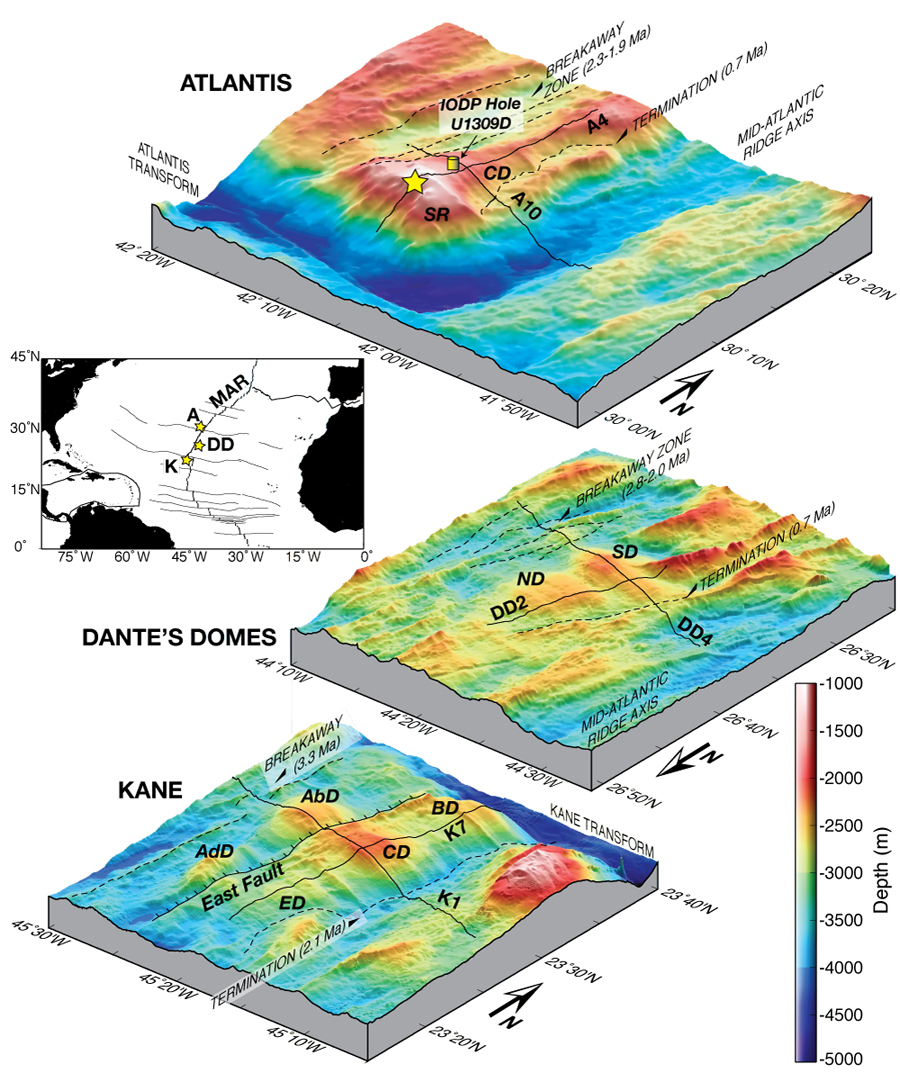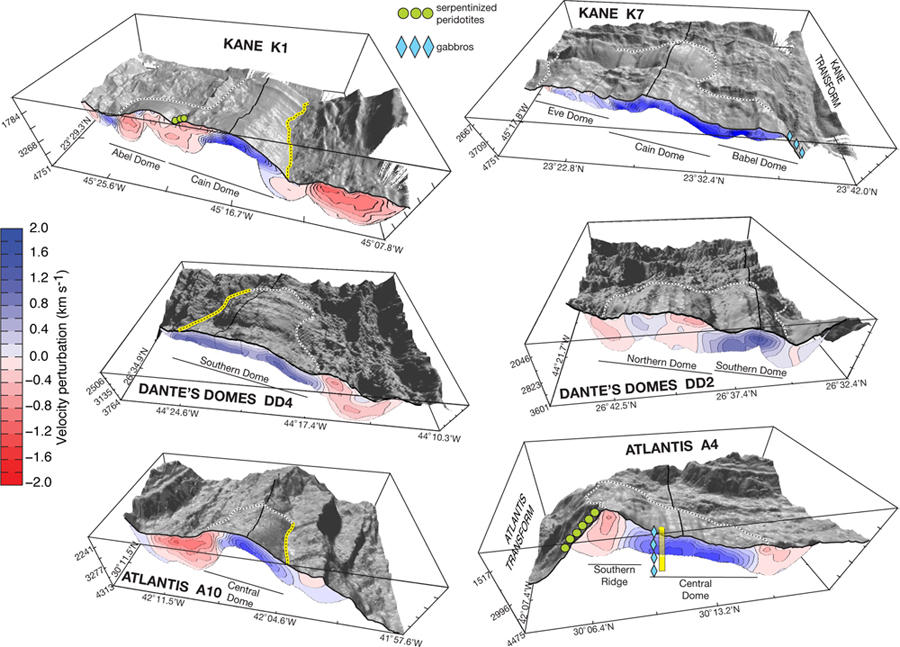Seismic Investigations of Oceanic Core Complexes
Oceanic core complexes (OCCs) are deep sections of the oceanic lithosphere exhumed tothe seafloor by long-lived detachment faults. When active, these faults constitute the sole extensional boundary between separating tectonic plates,and in some instances they can accommodate extension for 1-2 m.y. forming relatively smooth-surfaced, dome-shaped megamullions due to footwall rollover. These features commonly exhibit spreading-parallel corrugations or “mullions” that can have amplitudes up to several hundred meters.
The abundance of gabbros and peridotites recovered in most OCCs, together with gravity modeling that suggests the presence of mantle-like densities near the seafloor, indicates that OCCs may be ideal tectonic windows where the geological record of mantle flow and melt generation and migration can be studied. They also have the potential for hosting serpentinite-based hydrothermal systems. However, the relative abundances and distribution of these lithologies are not well constrained. Drilling at OCCs to date has recovered dominantly gabbroic rocks raising a question of the extent to which OCCs actually provide access to the oceanic mantle. Thus the origin and evolution of OCCs, their significance as tectonic windows into the oceanic lithosphere, and their potential as widespread hosts of serpentinite-based hydrothermal ecosystems remain uncertain.
We have conducted a seismic study of across three of the best developed and best studied OCCs on the Mid-Atlantic Ridge (MAR): Kane, Dante’s Domes, and Atlantis Massif. Using large-offset (6km) multichannel seismic data collected in 2001 aboard the R/V Maurice Ewing (Cruise EW0102) we have derived two-dimensional seismic tomography models of the upper ~0.5-1.7 km of the lithosphere across these three OCCs.
Our results show that large lateral variations in P-wave velocity, and we observe good correlations between velocity structure and lithology as documented by in situ geological samples and seafloor morphology. We use these correlations to show that gabbros are heterogeneously distributed as large (10s to >100 km2) bodies within serpentinized peridotites. Neither the gabbros nor the serpentinites show any systematic distribution with respect to along-isochron position within the enclosing spreading segment, indicating that melt extraction from the mantle is not necessarily focused atsegment centers, as has been commonly inferred. In the spreading direction, gabbros are consistently present toward the terminations of the detachment faults. This suggests enhanced magmatism during the late stage of OCC formation due either to natural variability in the magmatic cycle or to decompression melting during footwall exhumation. Heat introduced into the rift valley by flow and crystallization of this melt could weaken the axial lithosphere and result in formation of new faults, and it therefore may explain eventual abandonment of detachments that form OCCs. Detailed seismic studies of the kind described here, when constrained by seafloor morphology and geological samples, can distinguish between major lithological units such as volcanics, gabbros, and serpentinized peridotites at lateral scales of a few kilometers. Thus such studies have tremendous potential to elucidate the internal structure of the shallow lithosphere and to understand the tectonicand magmatic processes by which they were emplaced.

Three-dimensional perspectives of multibeam bathymetry over Atlantis, Kane, and Dante’s Domes oceanic core complexes. Solid lines locate seismic profiles. Dashed lines show locations of breakaways and terminations of detachment faults. Yellow star on Atlantis OCC locates the Lost City hydrothermal field. (Canales et al., [2008])

Three-dimensional renditions of seafloor topography with intersecting vertical sections of the velocity profiles showing velocity perturbations. Blue and red areas indicate velocities faster and slower than the reference model, respectively. Dashed lines on the seafloor topography indicate the limits of dominantly smooth, corrugated detachment surfaces; yellow segments show detachment terminations. Green dots and blue diamonds (serpentinite and gabbro, respectively) show dominant in situ lithologies. Vertical yellow bar in profile A4 locates IODP Hole U1309D. (Canales et al. [2008])
Collaborators
Brian Tucholke, Min Xu, and John Collins (WHOI)
Donna Blackman (SIO)
Publications
Blackman, D. K., J. P. Canales, and A. Harding (2009), Geophysical signatures of oceanic core complexes, Geophys. J. Int., 178, 593-613.
Canales, J.P. (2010), Small-scale structure of the Kane Oceanic Core Complex, Mid-Atlantic Ridge 23°30’N, from waveform tomography of multichannel seismic data, Geophys. Res. Lett., 37, L21305.
Canales, J. P., B. E. Tucholke, M. Xu, J. A. Collins, andD.L. Dubois (2008), Seismic evidence for large-scale compositional heterogeneityof oceanic core complexes, Geochem. Geophys. Geosyst., 9,Q08002.
Canales, J. P., B. E. Tucholke, and J. A. Collins (2004), Seismic reflection imaging of an oceanic detachment fault: Atlantis megamullion (Mid-Atlantic Ridge, 30o10'N), Earth Planet. Sci. Lett.,222, 543-560.
Xu, M., J. P. Canales, B. E. Tucholke, and D. L. Dubois (2009), Heterogeneus seismic velocity structure of the upper lithosphere at the Kane oceanic core complex, Mid-Atlantic Ridge, Geochem., Geophys., Geosyst., 10, Q10001.
